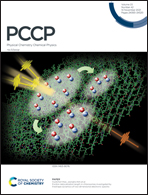Impact of chirality on the amorphous state of conglomerate forming systems: a case study of N-acetyl-α-methylbenzylamine†
Abstract
The present work aims at addressing the issue of molecular handedness in glassy and liquid states and its impact on heterogeneous equilibrium. For this purpose, we evaluated the glass forming ability (GFA), crystallization propensity, molecular mobility and hydrogen bonding structure of a chiral conglomerate forming system, N-acetyl-α-methylbenzylamine (Nac-MBA), at various enantiomeric excesses (ees) using experimental and computational techniques. We revealed that the rich relaxational landscape (Debye (D), α, βJG and ϒ) and the temperature dependence of the time scale of each process were insensitive to chirality. The most remarkable impact of chirality was expressed on the GFA and the recrystallization of heterochiral arrangements. In fact the GFA increases with decreasing ee, while the crystallization propensity increases with increasing ee. The counter enantiomer acted as a disruptor of crystallization and favored the glass formation upon cooling. The molecular dynamics simulation (MDS) results on the architecture of chiral sequences showed that homochiral sequences were more favorable when compared to heterochiral ones in the liquid state. However, this predisposition to form homochiral sequences in the liquid state was not the precursor of the future crystalline structure, since the liquid or the glassy system recrystallizes as heterochiral sequences. As per our understanding the crystallization was mostly controlled by the mean free migration path of an enantiomer to build homochiral or heterochiral sequences. In the present case, it seems that the mean free migration path achieved by an enantiomer for heterochiral sequences is shorter compared to homochiral arrangements in such a way that the crystallization of the metastable racemic compound is kinetically more favorable.



 Please wait while we load your content...
Please wait while we load your content...